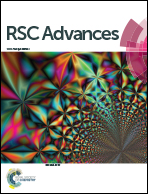Investigations on phosphorous doped hydrogenated amorphous silicon carbide thin films deposited by a filtered cathodic vacuum arc technique for photo detecting applications
Abstract
This paper reports the growth and properties of phosphorous doped hydrogenated amorphous silicon carbide (P doped a-SiC:H) thin films deposited at room temperature by a filtered cathodic vacuum arc (FCVA) technique using a phosphorous doped solid silicon target as a cathode in the presence of acetylene gas. These films have been characterized by X-ray diffraction (XRD), scanning electron microscopy, energy dispersive X-ray analysis, dark conductivity, activation energy, optical band gap, secondary ion mass spectroscopy, Raman spectroscopy, current–voltage, capacitance–voltage and photoconductive measurements. XRD results exhibit predominantly an amorphous phase for the films. The effect of the arc current on the properties of P doped a-SiC:H films have been studied. A P doped a-SiC:H/c-Si heterojunction diode was fabricated which showed a diode ideality factor between 1.5 to 1.7 and the density of states were 9.6 × 1016 to 4.8 × 1017 cm−3 eV−1. The photo response behaviors of the P doped a-SiC:H films have been tested by measuring the change in the electrical resistance on light illumination with the fast response and recovery time as 7.8 to 9.5 and 6.2 to 12.8 s, respectively. The P doped a-SiC:H film deposited at a 30 A arc current has shown a photo response of ∼1.6% at an illumination intensity of ∼100 mW cm−2.


 Please wait while we load your content...
Please wait while we load your content...